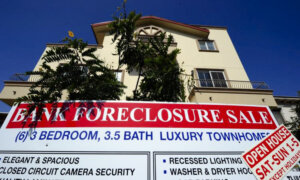The number of new homes sold in the United States hit the highest level since May 2023 last month amid an easing of mortgage rates, according to the Census Bureau.
New home sales in September reached a seasonally adjusted rate of 738,000 units annually, up by 4.1 percent from August and 6.3 percent from a year back, according to an Oct. 24 statement from the agency. Property sales rose in the Northeast and South while declining in the Midwest on a monthly basis. In the West, growth was flat. The jump in new home sales came as mortgage rates dropped last month.
Between the week that ended on Aug. 29 and the week that ended on Sept. 26, the average mortgage rate for a 30-year fixed-rate mortgage declined to 6.08 percent from 6.35, the lowest level in two years, according to data from Freddie Mac. Rates have since gone up to 6.54 percent for the week that ended on Oct. 24.
Commenting on the census data, Realtor.com pointed out in an Oct. 24 research report that the inventory of homes for sale has rebounded to April 2020 levels.
However, prices continue to remain high with the median price of new houses sold last month being $426,300.
While lower mortgage rates have provided some relief for prospective buyers, they still “aren’t seeing as many homes that fall into their budget range as the inventory growth suggests there should be,” the report states.
“Many, as we have seen, are turning to new construction, taking advantage of builder promotions like mortgage rate buydowns and focusing on the more affordable listings that builders offer,” it reads.
Amid the spike in new home sales, builder sentiment has also improved. In October, builder confidence in the market for newly built single-family homes rose by 2 points from the previous month, according to an Oct. 17 statement from the National Association of Home Builders (NAHB).
NAHB Chairman Carl Harris, a custom home builder from Wichita, Kansas, pointed out that builders now feel “more optimistic” about 2025 market conditions even though housing affordability continues to pose a challenge.
The “wild card” for the housing market outlook is the U.S. General Election on Nov. 5, he noted.
“With housing policy a top tier issue for candidates, policymakers should be focused on supply-side solutions to the housing crisis,” he said.
Housing and Elections
Both presidential candidates, former President Donald Trump and Vice President Kamala Harris, have put forward proposals on how they plan to tackle the housing issues facing the country.Harris has promised that she would “end the national housing supply crisis in her first term,” proposing to construct 3 million affordable homes and rental units. She also plans on giving first-time homebuyers up to $25,000 in down payment assistance.
The Democratic candidate intends to deal with red tape to speed up the process of constructing homes. She said she would sign legislation seeking to prohibit new forms of price fixing done by “corporate landlords.”
Trump has promised to bring down prices and “make America affordable again.”
According to the 2024 Republican National Committee platform posted on Trump’s campaign website, the GOP plans to help new home buyers by bringing down mortgage rates. This will be done by “slashing inflation.”
Republicans also aim to “open limited portions of federal lands to allow for new home construction, promote homeownership through tax incentives and support for first-time buyers, and cut unnecessary regulations that raise housing costs,” according to the Republican Party platform.
Back in March 2023, the former president also floated the idea of building new cities in the United States that would give “hundreds of thousands of young people and hardworking families a new shot at homeownership.”
An Oct. 15 survey conducted by real estate brokerage Redfin found that more than a quarter of respondents ranked housing affordability as a key issue that impacts which candidate they support in the presidential race.
Voters backing Harris were found to be “slightly more likely” than Trump voters to list housing affordability as a major issue. The company speculated that this difference could be because “Democrats are more likely to live in expensive coastal areas.”
Chen Zhao, Redfin’s economic research lead, partly attributed the recent increase in mortgage rates over the past weeks to shifting expectations among investors regarding the upcoming elections.
“Investors in the bond market are particularly worried about the possibility of increased government debt after the election,” he said.
“They’re concerned that one party could end up controlling both the White House and Congress, which would increase government spending more. That concern, along with strong economic data, is pushing up 10-year treasury yields and mortgage rates.”














